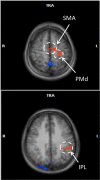Improvement in precision grip force control with self-modulation of primary motor cortex during motor imagery
- PMID: 25762907
- PMCID: PMC4327737
- DOI: 10.3389/fnbeh.2015.00018
Improvement in precision grip force control with self-modulation of primary motor cortex during motor imagery
Abstract
Motor imagery (MI) has shown effectiveness in enhancing motor performance. This may be due to the common neural mechanisms underlying MI and motor execution (ME). The main region of the ME network, the primary motor cortex (M1), has been consistently linked to motor performance. However, the activation of M1 during motor imagery is controversial, which may account for inconsistent rehabilitation therapy outcomes using MI. Here, we examined the relationship between contralateral M1 (cM1) activation during MI and changes in sensorimotor performance. To aid cM1 activity modulation during MI, we used real-time fMRI neurofeedback-guided MI based on cM1 hand area blood oxygen level dependent (BOLD) signal in healthy subjects, performing kinesthetic MI of pinching. We used multiple regression analysis to examine the correlation between cM1 BOLD signal and changes in motor performance during an isometric pinching task of those subjects who were able to activate cM1 during motor imagery. Activities in premotor and parietal regions were used as covariates. We found that cM1 activity was positively correlated to improvements in accuracy as well as overall performance improvements, whereas other regions in the sensorimotor network were not. The association between cM1 activation during MI with performance changes indicates that subjects with stronger cM1 activation during MI may benefit more from MI training, with implications toward targeted neurotherapy.
Keywords: motor imagery; motor skill; neurofeedback; real-time fMRI.
Figures





Similar articles
-
Modulation of functional network with real-time fMRI feedback training of right premotor cortex activity.Neuropsychologia. 2014 Sep;62:111-23. doi: 10.1016/j.neuropsychologia.2014.07.012. Epub 2014 Jul 21. Neuropsychologia. 2014. PMID: 25058055
-
Neurofeedback-guided kinesthetic motor imagery training in Parkinson's disease: Randomized trial.Neuroimage Clin. 2022;34:102980. doi: 10.1016/j.nicl.2022.102980. Epub 2022 Mar 2. Neuroimage Clin. 2022. PMID: 35247729 Free PMC article. Clinical Trial.
-
Enhancing Motor Network Activity Using Real-Time Functional MRI Neurofeedback of Left Premotor Cortex.Front Behav Neurosci. 2015 Dec 24;9:341. doi: 10.3389/fnbeh.2015.00341. eCollection 2015. Front Behav Neurosci. 2015. PMID: 26733832 Free PMC article.
-
Motor Imagery: How to Assess, Improve Its Performance, and Apply It for Psychosis Diagnostics.Diagnostics (Basel). 2022 Apr 11;12(4):949. doi: 10.3390/diagnostics12040949. Diagnostics (Basel). 2022. PMID: 35453997 Free PMC article. Review.
-
Investigating the Viability of Motor Imagery as a Physical Rehabilitation Treatment for Patients With Stroke-Induced Motor Cortical Damage.Cureus. 2021 Mar 19;13(3):e14001. doi: 10.7759/cureus.14001. Cureus. 2021. PMID: 33884242 Free PMC article. Review.
Cited by
-
A Multi-Target Motor Imagery Training Using Bimodal EEG-fMRI Neurofeedback: A Pilot Study in Chronic Stroke Patients.Front Hum Neurosci. 2020 Feb 18;14:37. doi: 10.3389/fnhum.2020.00037. eCollection 2020. Front Hum Neurosci. 2020. PMID: 32132910 Free PMC article.
-
Four methods of brain pattern analyses of fMRI signals associated with wrist extension versus wrist flexion studied for potential use in future motor learning BCI.PLoS One. 2021 Aug 17;16(8):e0254338. doi: 10.1371/journal.pone.0254338. eCollection 2021. PLoS One. 2021. PMID: 34403422 Free PMC article. Clinical Trial.
-
Effect of motor imagery on excitability of spinal neural function and its impact on the accuracy of movement-considering the point at which subjects subjectively determine the 50%MVC point.J Phys Ther Sci. 2016 Dec;28(12):3416-3420. doi: 10.1589/jpts.28.3416. Epub 2016 Dec 27. J Phys Ther Sci. 2016. PMID: 28174464 Free PMC article.
-
The potential of real-time fMRI neurofeedback for stroke rehabilitation: A systematic review.Cortex. 2018 Oct;107:148-165. doi: 10.1016/j.cortex.2017.09.006. Epub 2017 Sep 18. Cortex. 2018. PMID: 28992948 Free PMC article.
-
From lab to life: challenges and perspectives of fNIRS for haemodynamic-based neurofeedback in real-world environments.Philos Trans R Soc Lond B Biol Sci. 2024 Dec 2;379(1915):20230087. doi: 10.1098/rstb.2023.0087. Epub 2024 Oct 21. Philos Trans R Soc Lond B Biol Sci. 2024. PMID: 39428887 Free PMC article. Review.
References
-
- Boecker H., Ceballos-Baumann A. O., Bartenstein P., Dagher A., Forster K., Haslinger B., et al. (2002). A H215O positron emission tomography study on mental imagery of movement sequences–the effect of modulating sequence length and direction. Neuroimage 17, 999–1009 10.1006/nimg.2002.1139 - DOI - PubMed
Grants and funding
LinkOut - more resources
Full Text Sources
Other Literature Sources

